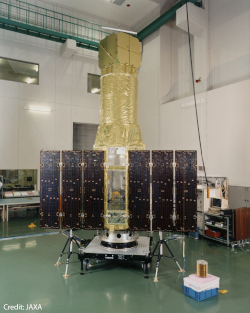HEAPOW: The Launch of ASCA (2023 Feb 27)
Posted: Mon Mar 06, 2023 3:48 pm
 The Launch of ASCA
The Launch of ASCA
ASCA, the Advanced Satellite for Cosmology and Astrophysics, was launched 30 years ago. ASCA was the fourth Japanese cosmic X-ray astronomy mission, and the second for which NASA provided part of the science payload. The name ASCA suggest the word Asuka, an ancient Japanese word for a flying bird. As shown in the picture above (when the integrated observatory was undergoing pre-launch testing), the satellite with its long telescope housing and the extended solar panels do look like certain birds. The ASCA observatory was a ground-breaking X-ray space observatory. ASCA was the first major X-ray observatory to use CCD detectors to both image X-rays from neutron stars, black holes, and other cosmic objects and also to record the distribution of X-ray energy from those objects. ASCA was also important because it demonstrated the use of economical, lightweight thin foil X-ray mirrors in a major X-ray space observatory (thin foil optics were first used on-orbit by the Broad-band X-ray Telescope which flew for 9 days on the Space Shuttle Columbia during the Astro-1 mission in 1990). ASCA produced ground-breaking science: ASCA measured X-rays from matter plunging into black holes; it discovered of "middleweight" black holes; it provided proof that supernova remnants can produce cosmic rays; and measured the chemical makeup of stars and galaxies. After eight productive years in orbit, ASCA re-entered the atmosphere at 05:21 UT on March 2, 2001 over the western Pacific. ASCA set the stage for more advanced Japanese X-ray observatories, notably Suzaku, which flew from 2005 to 2015, and the upcoming XRISM observatory, slated for launch later this year.
HEASARC: ASCA X-ray Astronomy Data
| << Previous HEAPOW | High Energy Astrophysics Picture of the Week | Next HEAPOW >> |